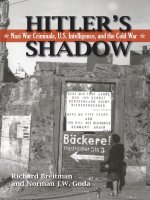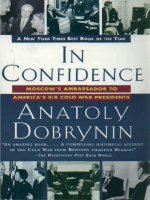The Communist Wars Cold War, Korean War Vietnam War
Bạn đang xem bản rút gọn của tài liệu. Xem và tải ngay bản đầy đủ của tài liệu tại đây (2.12 MB, 33 trang )
The Communist WarsCold War, Korean War &
Vietnam War
The Cold War- No, it
was not a very “cold”
war!
Cold War Ideologies
United States
Encouraged
democracy
Wanted to gain
access to raw
materials and
markets
Wanted to help
create more
European economies
Reunite Germany
Soviet Union
Encouraged
communism
Wanted to use raw
materials to rebuild
economy
Wanted to control
Eastern Europe
Keep Germany divided
Key Vocabulary
“Iron Curtain”
“McCarthyism”
Containment policy
Domino Theory
Marshall Plan
Senator Joseph McCarthy
Events of Cold War
Berlin Wall created
NATO/ Warsaw Pact
SEATO
Nuclear wars/ “Arms Race”
“Space Race”
Truman Doctrine
Events of the Cold War cont’d
Brinkmanship/Détente
U-2 incident
Berlin Blockade/Berlin Airlift
Kitchen Debate
1980 Olympic Ice Hockey Game- Semifinals- US vs.
USSR
Sputnik- October 4, 1957 (first satellite put into space)
During the 1950s, the Third World emerged as key arena of Cold War
competition. The May 1954 Battle of Dien Bien Phu was the final battle
in the First Indochina War between France and pro-independence
nationalists, but laid the groundwork for U.S. involvement in the region.
JULY 24, 1959
Brezhnev and Nixon talk during Brezhnev's June 1973 visit to
Washington—a high-water mark in détente between the United
States and the Soviet Union.
In the late 1980s and early 1990s, the Soviet Union quickly abandoned its
Cold War commitments as the state and Communist Party rule
unraveled. By late 1991, opposition to Gorbachev's radical reforms had
triggered the Soviet coup attempt of 1991, but the failure of the coup
wound up accelerating the dissolution of the USSR. Above, Gorbachev
and Boris Yeltsin spar over the events of the coup, with Yeltsin accusing
Gorbachev of failing to prevent the crisis. Later, Gorbachev would
accuse Yeltsin of tearing the Soviet Union apart out of a desire to
advance his own personal interests.
KOREAN
WAR
Korean War
Background
Korea divided at the 38th parallel after World
War II, ending Japanese control
Northern part- occupied by Soviet troops until
1948
Southern part- occupied by Americans until
1949
Truman convinced of a repeat of Germany in
North Korea
Events of War
War began when communist North Korea invaded
South Korea in 1950, capturing the capital, Seoul
South Korea asks UN to intervene
UN Security Council voted to aid South Korea
15 countries participated under the leadership of
MacArthur
United States led the peacekeeping forces
20 other nations eventually became involved in the
war
Koreans saw it primarily as a civil war
General Douglas
MacArthur
In October 1950, after routing North Korean soldiers from the southern half of the
Korea Peninsula, United States general Douglas MacArthur sent troops across the
38th parallel into North Korea. In November Chinese troops entered the Korean
War on the side of the North, and by early December North Korea was cleared of
U.S. and South Korean troops.
Outcome/Legacy of the Korean
War
Both countries remained divided
5 million died in process
North Korea built collective farms and nuclear weapons,
yet suffer economically and socially
South Korea prospered with massive aid from the US
and grew tremendously economically
In July 1953 North Korea and China, allies in the Korean War, signed a truce
agreement at Panmunjeom (P’anmunjŏm) with the United Nations command
that had supported South Korea. The agreement ended fighting on the Korea
Peninsula, but a permanent peace settlement between South Korea and North
Korea has not been reached.
VIETNAM
WAR
Vietnam War
Background
Once a French colony
Main cause of the war- failure of Vietnamese
nationalists to gain control of southern
Vietnam after their struggle with France
(1946- 1954)
Ho Chi Minh
“Charlie”- Vietcong
Events of Vietnam War
A Divided Country
Ngo Dinh Diem- South
Ho Chi Minh- North
U.S. deployed large numbers of troops to South
Vietnam between 1954 and 1973
Ho Chi Minh Trail
Guerilla warfare
TET Offensive
War finally concluded on April 30, 1975 with the
fall of Saigon
President Eisenhower and Secretary of State John Foster
Dulles greet President Ngo Dinh Diem in Washington.









